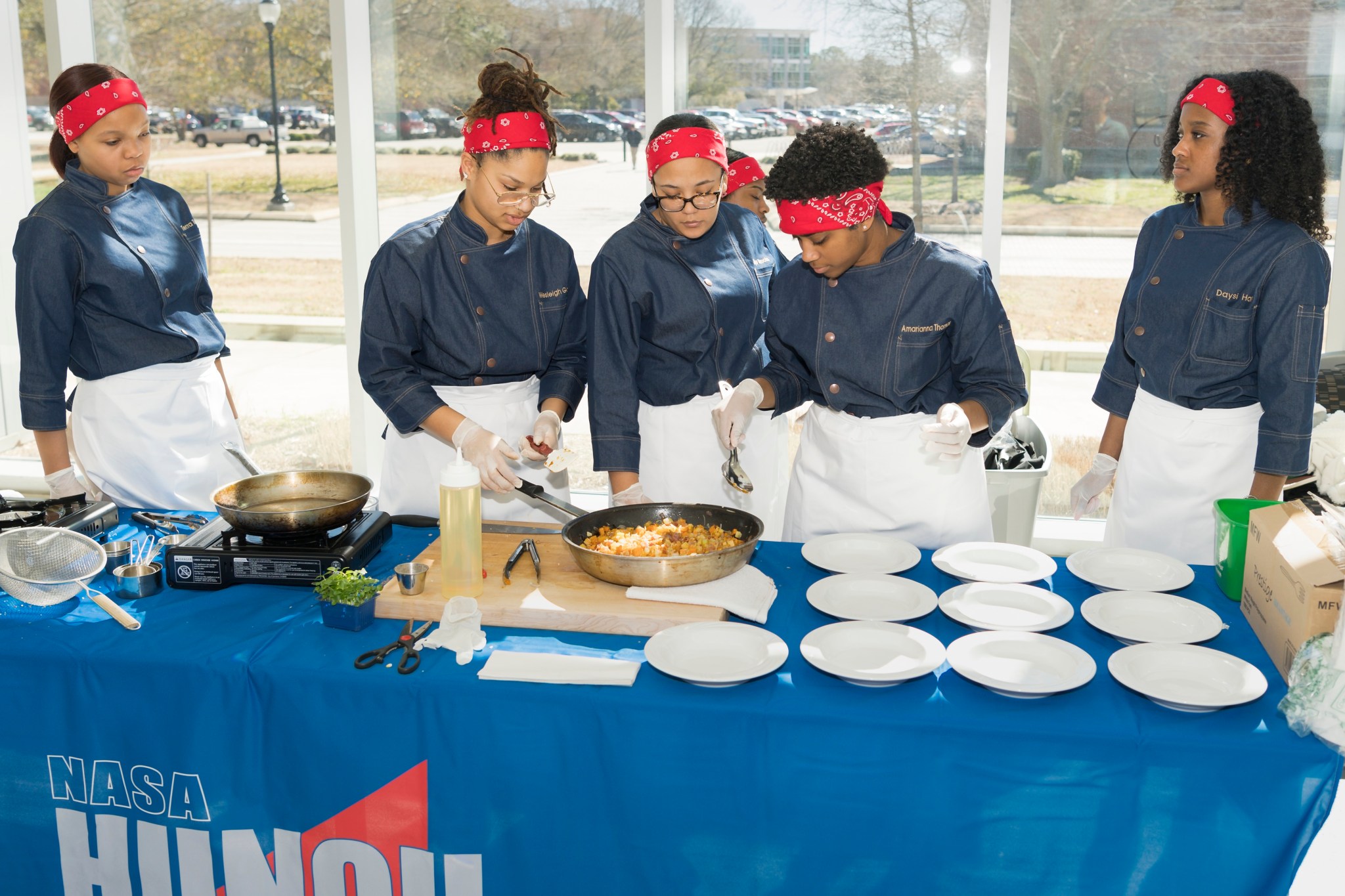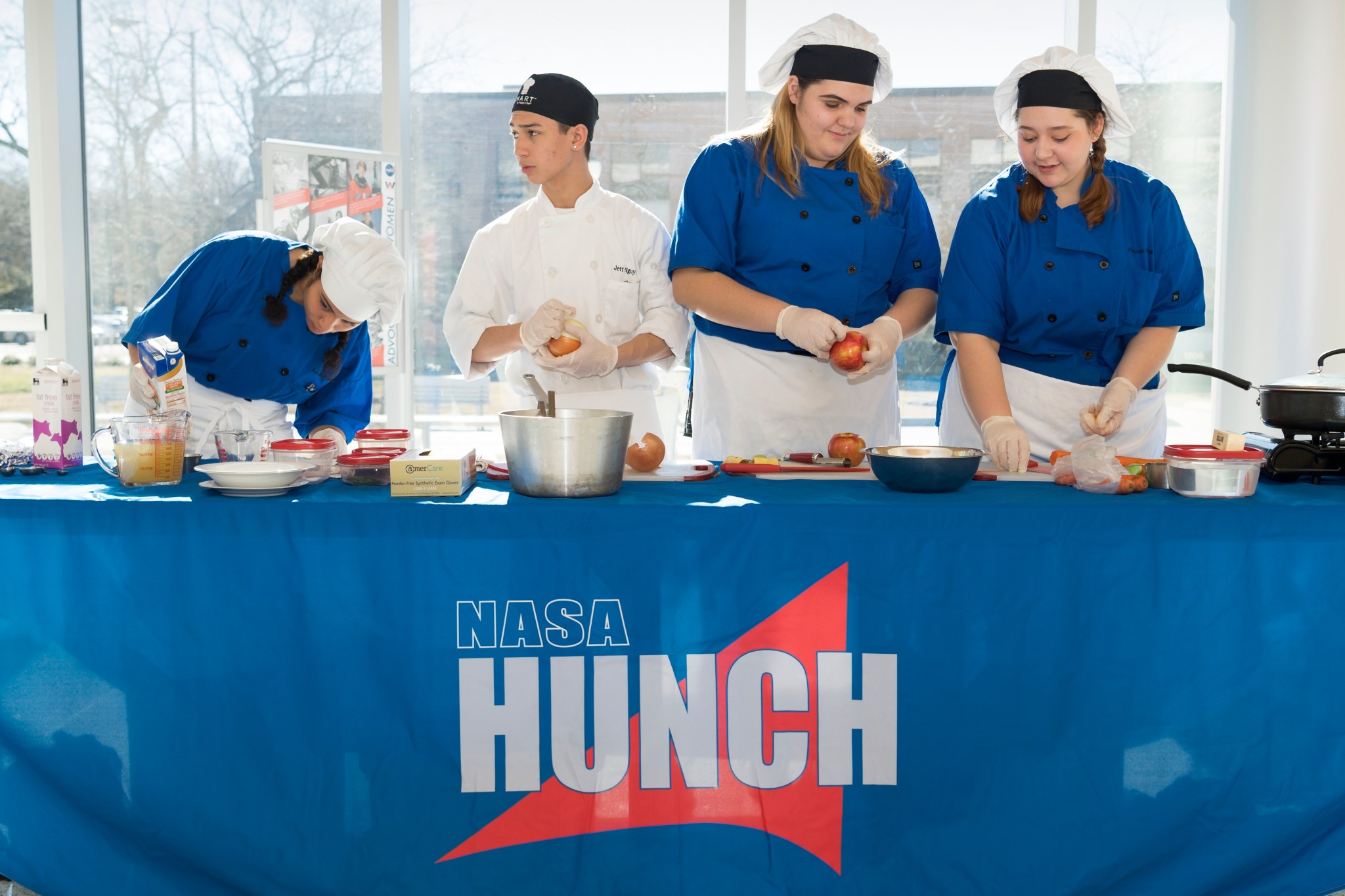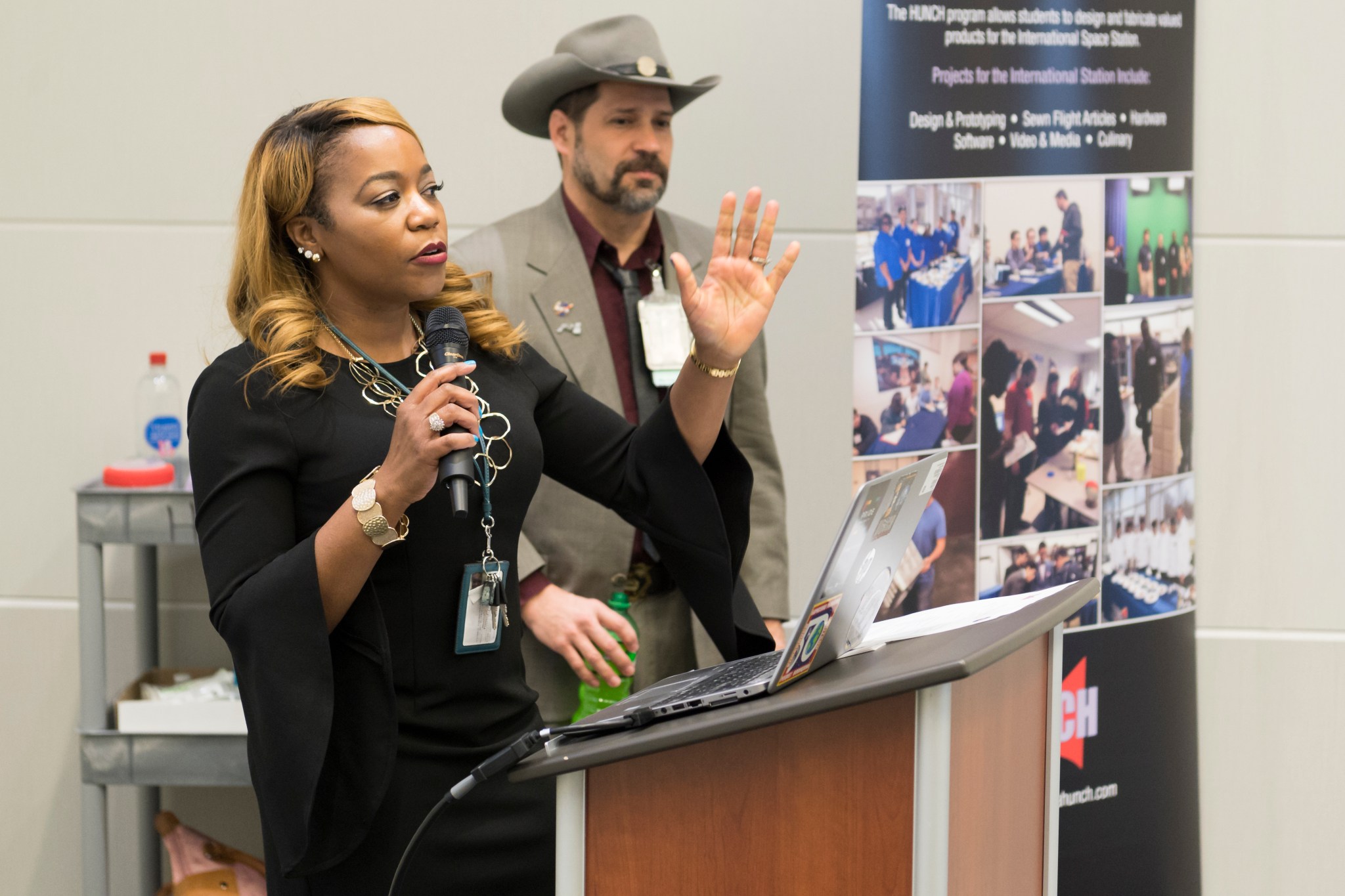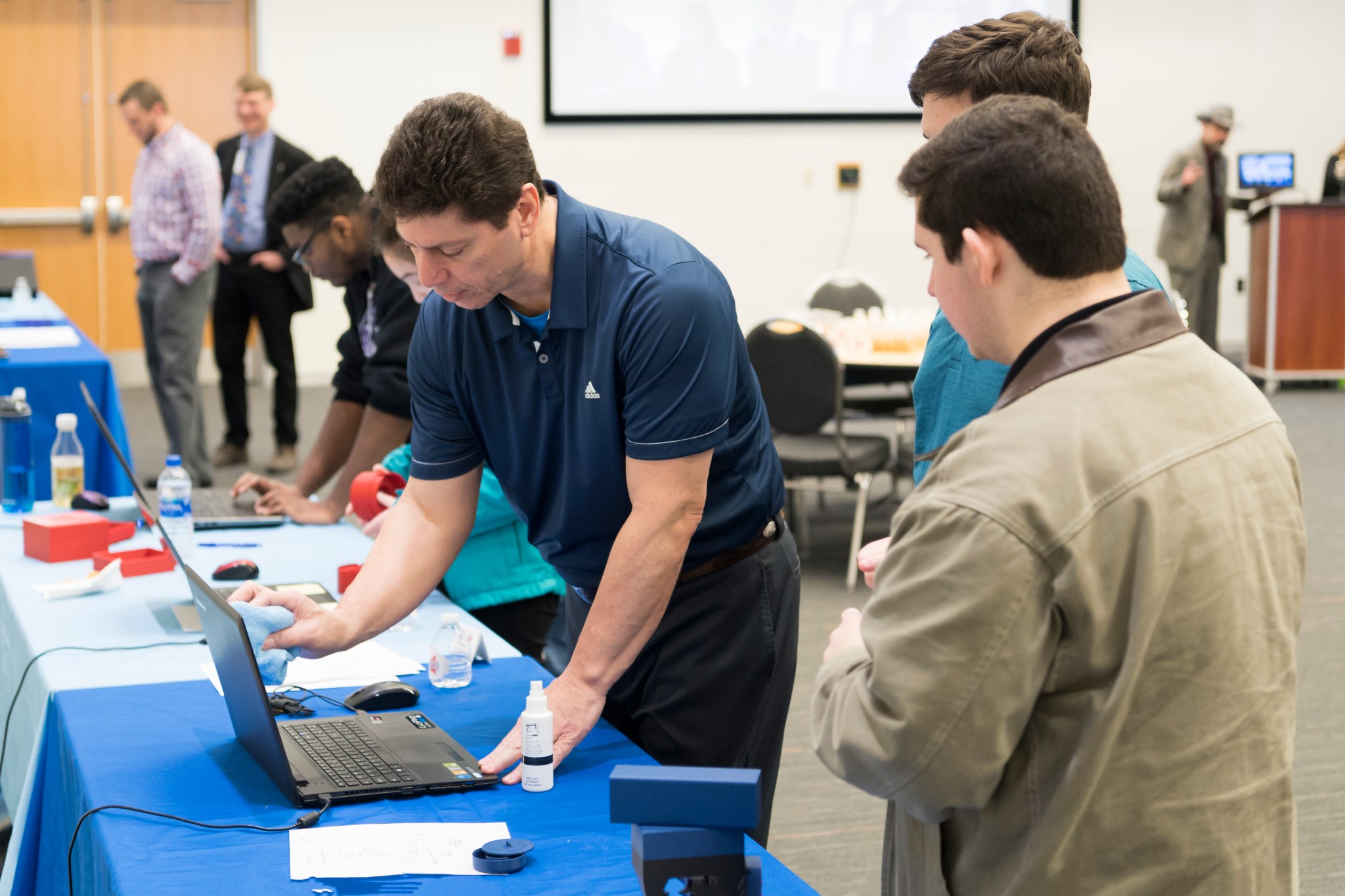How many ways can you cook butternut squash? For two teams of local high school students, the question had to be answered if they want to see their creations launched into space.
Teams, including two from high schools competing at NASA’s Langley Research Center in Hampton, Virginia, took part in a nationwide program Feb. 25-26 to put their best fruit or vegetable side dish forward as part of NASA’s HUNCH program. The goal is to one day feed their dishes to astronauts aboard the International Space Station (ISS).
HUNCH, or High school students United with NASA to Create Hardware, develops high school students in many ways by highlighting their talents in order to contribute to NASA’s missions. The program provides students hands-on experience with the space agency — such as building NASA-designed parts for use by agency personnel, or food for astronauts to enjoy.
“The HUNCH Program can change the trajectory of a student’s life, by providing various avenues beyond the STEM (science, technology, engineering, and math) field and opportunities to participate in the global effort to research in space,” said Yolanda Watford Simmons, program manager of Langley’s Engineering Directorate and the center’s HUNCH program.
Food Fit for Space
An eight-person judging panel at Langley sampled two dishes — a maple butternut squash and apple soup from New Horizons Woodside Technical Education Center in Newport News, Virginia, and a harvest butternut squash hash from Phoebus High School in Hampton, Virginia.
Both teams vied to make it to the final 10 teams that will compete at NASA’s Johnson Space Center in Houston in April 15, where their work will be judged by Johnson Food Lab personnel, industry professionals, the ISS Program Office, and astronauts for quality and taste. They’ll also be rated on a required research paper and presentation video. The winning entrée, to be announced in May, will be created by the Johnson Space Food Lab and sent up to the space station for astronauts to enjoy.
Both teams agreed that staying within the tight nutritional guidelines while creating food with taste was the toughest, yet most rewarding, aspect of the challenge.
“We made sure none of the components were lost and that the flavor was still there,” said Keerah Williams of the New Horizons team.
Williams and her classmates wanted something unique and portable that ISS astronauts could enjoy.
“I’m very confident in the recipe,” she said. “We tried this out many times to make sure it was to the right consistency, to make sure we had all the flavors melded together perfectly. It couldn’t have come out any better.”
The Phoebus team aimed for their recipe to have organic flavors – which was easier said than done.
“We had a lot of trial and error,” said Wesleigh Gomes, a Phoebus High junior.
They experimented in how to cook the food, notably the root vegetables in the dish, and when they found a method that worked, the rest of the process fell into place.
“It’s really cool to see how stuff goes into space or the process you have to go through,” Gomes said. “You just don’t pull out a stove or a hot pan and cook.”
Gomes has food intolerances, which factored her efforts in the challenge. With her diet restrictions, this challenge dovetailed her interests in the food science industry, she said.
Her diet is not as a restrictive as it appears at first glance, as it helps her see the power of food, she said.
“It’s expanded my palette a lot,” Gomes said. “It’s allowed me to try new things and create food that tastes more from the earth and organic and simpler, but also has very impactful flavors.”
Phoebus High School’s Harvest Hash dish ranked amongst the top ten schools nationally to compete in finals. Johnson Food Lab personnel will judge the students’ dish, research paper and presentation video.
Space Tech to Improve Life on ISS
HUNCH at Langley wasn’t just about making a side dish, as the center also hosted a Critical Design Review on Feb. 26 for six teams of high school students who fabricated real-world products to tackle problems — both large and small — faced by the men and women who make space their home.
During a mid-year project review session at Langley, the students received guidance from Glenn Johnson, NASA HUNCH design engineer, as well as two Langley engineers, who served as reviewers.
“We’ve been doing a lot of excellent work, both with ideas that have come from students at Langley as well as students from around the country,” he said.
The six teams — Hampton High School in Hampton, Virginia; Grafton High School and York High School in York County, Virginia; Poquoson High School in Poquoson, Virginia; Warhill High School in Williamsburg, Virginia; and the North Carolina School of Science and Mathematics in Durham, North Carolina — had to explain their projects to reviewers. The teams from Hampton High, Grafton High, and North Carolina attended the review through a video link.
Many of the projects are items personally requested by ISS crew to help ease living conditions aboard the station, giving students the opportunity to really make an impact on the lives of astronauts. Other projects come from flight crew systems and operational groups at NASA that need additional idea development. The final design and prototyping review will be April 16 at Johnson.
Andrew Stewart, a junior on the York High team, helped craft food packaging solutions for the ISS.
“I like food and I don’t like it moving around too much, and I definitely don’t want it spilling around,” he said. “I thought it would be a good idea to compact it to help the astronauts keep it in one place.”
Stewart’s team had circular and square drawers of food storage. The circular container can also be used to mix certain foods, like yogurt.
“Right now it’s at the early stages,” he said. “For right now, I feel we’re at a good spot.”
Stewart wants to try engineering as a career. He thinks HUNCH is a good glimpse into what he can accomplish if he sets down that path.
“I feel that it’s something I can do and really get into, if I put everything I got into this,” he said. “This is something I can focus on and have a future in.”
Three Langley student teams were evaluated by the HUNCH Design Review team and deemed to have demonstrated significant design quality and ideas to warrant recognition as a contender for the Final Design Review at Johnson – Poquoson High (Spare Tools Pouch and Augmented Reality Object Recognition: QR Code), York High (Advanced Resistive Exercise Device Clip) and Warhill High (Spare Tools Pouch). Approximately 70 teams nationwide from the contender’s list will be invited to Johnson.
Eric Gillard
NASA Langley Research Center































